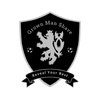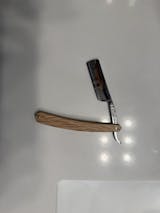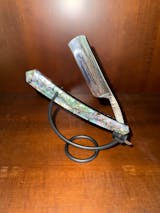By comparison to the ancient tools, the modern straight razor looks like a sophisticated piece of technology. The earliest iteration of the straight razor likely came in the late 1600s and has been used for traditional manual shaving for over two hundred years. Since then, it's experienced ebbs and flows in its popularity, and in recent years has become trendy again—as part of the mortal uprising against environment-destroying and expensive plastic cartridge razors.
Early razors were basically any sharp thing anyone could get their hands. Evidenced by cave drawings from the Stone Age and ancient archaeological digs that unearthed artifacts from the middle ages and prehistoric times, the first shave began with clam shells, shark's teeth or pumice stones to scrape of facial hair. Later in ancient Egypt copper razors have been uncovered in ancient tombs.
It's unclear whether they cut their facial hair for aesthetic or pragmatic reasons; some sources say it was mostly to address vermin that would nestle into their facial hair and cause a terrible itch and rash.
Centuries later, in ancient Rome, the early versions of the straight razor were also simple tools. They used a device called the Novacila made from a block of iron with finger holes and a blade that resembled brass knuckles.
Of the different types of razors, straight razors have probably changed the least in appearance from their inception.
Part of its current appeal with wet shaving aficionados is the nostalgia of a simpler time shaving with a traditional products, its simplicity and the ritual—interestingly enough its the lack of innovation that really drives the allure of the modern straight razor.
Is The Modern Straight Edge Razor Making A Comeback?
According to a 2016 essay in Outside Magazine, the straight razor scene in the 2012 James Bond movie, Skyfall, caused a sudden and dramatic increase in straight razor sales all over the world.
The essay cites a Dovo Solingen executive who said in the early 2000s the company sold fewer than 8,000 straight razors a year, and in 2016, they had over 100,000 orders placed.
The straight razor is back, and it's probably not going anywhere; an increasing number of men are interested in traditional wet shaving, and many men are becoming straight razor users to that end.

What is a straight razor?
Modern straight razors are called open razors, straight edge razor or a cut-throat razor defined by its long exposed single blade that can be folded back into its handle.
For a long time, it was a service performed usually by a skilled barber—one of the oldest skilled trades. They were also called "Barbers Surgeons." The local Barber Surgeon was an integral part of the community responsible for men's grooming, styling, and dressing, as well as performing surgery and dentistry. Because of their steady hands and experience, offering a shave with a razor was just evolutionarily intuitive.
Today, using straight razors at home has had made a massive resurgence in wet shaving routines. Alone, in front of the mirror, for many men, the morning shave has recently become a sacred part of the daily routine albeit a ritual, and the barbershop shave has become a luxurious premium treatment, like a day at the spa.
Why is it called a straight razor?
The name is fitting: The blade is one long straight edge, and it's the defining feature of the razor. It's the longest and most exposed blade available for shaving.
The early versions were a status symbol
In the late 1600s, in the early days of the modern version of the straight razor, they were a luxury good and were seen as a status symbol.
The silver steel gloss was a monumental aesthetic update, and around the same time, manufacturers began making the handles out of nicer materials—ivory and tortoiseshell among them.
In some cases, small illustrations were etched into the blade, and it was even more common for a man's initials to be engraved into the blade.

When was the earliest straight razor made?
Let us start with a brief history...In 1680, a British man called John Spencer was behind an operation making "Sheffield wares" out of Sheffield, England. He was an industrialist and his company was manufacturing multiple different steel products, which included clocks and cutlery and also an early form of the straight razor.
As the straight razor evolved, the original Sheffield steel, with its characteristic deep gloss finish also known as "Sheffield silver steel" remained the the most sought after material for a blade and still is in use today by such manufacturers such as Thiers Issard a luxury straight razor brand known for its custom scales and blades.
Generations later Sheffield steel is still considered to be superior quality and the absolute best material to make the blades from because of its durability and resistance to rust, the downside because of its hardness it can be challenging to sharpen with a hone and strop.
If you are on the lookout for a vintage or antique razor the old wedge blades made of the Sheffield steel were marked with the words "cast steel" or "warranted." If you ever come across any antique straight razors and find those markings, then that razor was made in the late 1700s or early 1800s in England.

More Straight Razor History
In 1740, another British man who was called Benjamin Huntsman was making straight razors complete with decorated handles (scales). His blades were made from highly polished steel with a hollow grind, and he also made other steel products. Hunstman was an innovator and developed this process of manufacturing on his own: He poured molten steel into molds he'd made and then shaped the metalware, sometimes even including intricate decorative handles inlaid with precious metals such as silver, other precious stones, and horn handles.
His process also allowed him to make blades with a hollow ground blade profile, which basically is just a thinner edge of the blade than the earlier wedge blades which could be crude.
Huntsman's process was quickly adopted by the French and became the dominant mode of production.
In the late 19th century, straight razor production shifted from manual to industrial, and straight razor manufacturers began to mass-produce for the first time.
Why did we stop using straight razors?
In the late 1800s, the Kampfe brothers had made headway on their new safety razor, which proposed an alternative to the straight razor. Their product would decrease the risk of cutting yourself without compromising the quality of the shave.
In 1904, King Camp Gillette patented the double-edged safety razor. He took the Kampfe brothers' basic design and made some changes, and his new product was revolutionary for two reasons. First, like the Kampfe product, men could shave at home without fear of cutting themselves. But also the blades were disposable, which meant the user would never had to see a professional to have his blade stropped and honed.
With these new safety razors or the double edge razor, you could do everything by yourself. Its rapid increase in popularity was simultaneous with the straight razor's decline in popularity.
The U.S. military even issued a double-edged safety razor and disposable blades to its soldiers during the First World War, and that was kind of the nail in the coffin for the straight razor. Shaving was actually very important for the soldiers because they needed a clean-shaven face for their gas masks to be completely effective.
After the war, many American men had a safety razor of their own and would only have to buy the replaceable blades.
Safety razors became the dominant shaving method of the twentieth century. Safety razors basically killed straight razors.
Electric razors were introduced to the market in 1930, and Bic introduced disposable razors in 1974. Convenience was becoming an American cultural priority, and in the following decades, straight razors eventually fell completely out of fashion.
Isn't it unsafe?
Jean-Jacques Perret invented a blade guard for the straight razor in 1762, and that kickstarted the transition away from relying exclusively on professional barbers for a shave, although men were still largely unconfident in their personal shaving expertise.
Perret's original blade guard was a wooden sleeve that slid over the majority of the blade, leaving only the sharp edge exposed. His design made it impossible to slice off your entire ear but didn't prevent the routine nicks and cuts, that only come with expertise and experience.

Are there different types of blades?
Cutthroat razors or the straight razor is made of three different types of steel:
- Carbon steel
- Stainless steel
- Damascus steel
Compared to other metals available, a stainless steel blade is the best and most economical choice for a straight razor because it stays sharper and rust-free for longer. High carbon steel is a great choice for beginners because it keeps a sharper edge longer and is easy to strop. For a more luxurious option, the original Sheffield silver steel—famous for its durability and resistance to rust—is considered to be superior quality steel and that's why the material is still used today, even after so many years.
What are the handles "Scales" made of?
Most decorated handles today are made of durable wood such as poplar wood, orange beechwood, French oak, and sometimes other more exotic woods. There are many variations and even high-grade resins. Traditionally, the handles of open razors were made of all sorts of other fascinating materials: bone, elephant ivory, tortoiseshell, a mollusk shell known as "Mother of Pearl," and buffalo horn are among the common materials used to make handles.
In the late 21st century, poaching elephants for their ivory became absolutely illegal and closely monitored for reasons of animal cruelty. Many elephant species were becoming endangered. Today it's illegal to kill an elephant for its ivory virtually everywhere, but it's not illegal to sell or buy an ivory-handled straight razor that was made before 1989.
For many reasons, those natural materials have become antiquated. But the aesthetics have persisted, and today cut-throat razors are made with faux or synthetic materials such as high-grade resins—for example, high-grade ivory resin, faux tortoiseshell, and imitation pearl handles.
The Basic Anatomy Of A Modern Razor

The two main parts of a straight razor are the blade and the handle. The end of the blade that connects to the handle is called the tang, and it's connected by a pivot pin.
When not in use, the blade folds back into the handle.
The "tang" is a metal extension of the blade that bridges the blade and the handle, and you grip it while shaving.
The tang is the closest thing to the blade that isn't the blade itself, so holding the razor here while shaving allows for more technical control while shaving.
Sometimes the tang has some little horizontal divots and ridges for increased texture so the razor doesn't slip in your fingers when it's wet. The divots and ridges are called the "jimps."
There are many brands that make straight razors, and the product has a long history, so of course, there are variations, but both the tang and the jimps are consistent characteristics across brand and time.
The process of making a straight razor
Step 1: Forging
The steel is melted and shaped into the shape of a blade, and before the metal has hardened, they drill a hole toward the end of the blade (the tang of the pivot point, if we're getting technical) where the blade will connect to the handle.
Step 2: Hardening and tempering
Depending on the specific steel or type of metal, the blade is heated to a specific temperature for it to then cool and reach the optimum hardness. The tempering phase is basically the fine-tuning; the blade is placed into hot oil to basically make it slightly less hard, and this process can be lengthened to make the blade even softer. Blades are usually categorized as hard-tempered, medium-tempered, or soft-tempered.
Step 3: Grinding
The manufacturer uses a grinding wheel to sharpen the blade. There are multiple types of approaches to grinding, which basically just means the edge of the blade comes in different shapes. Early straight razors had wedge blades, which could be crude, but the dominant shape has become hollow grinding. Hollow ground blades are basically just a thinner razor edge. Hollow ground blades are sharper than the wedge and allow for a closer and more specific shave.
Step 4: Finishing
The manufacturer applies a gloss, which is good for durability and aesthetics. Some glosses are more expensive and higher quality than others; the most expensive one is the mirror gloss. The Sheffield blades were known for their highly polished steel with a deep gloss finish. In some cases, the blades' appearance is even further enhanced by processes like a gold wash, which give the blade a glossy finish of solid gold. Other metal plating is sometimes done too, using nickel or copper, but that process is antiquated for its low quality; those metals erode quickly.
Step 5: Sharpening
Sharpening happens periodically. As opposed to safety razors that have a disposable blade that is easily replaced, straight razors are purchased once and then must be maintained. Sharpening is mostly a professional service. The blade is honed against the flat side of rotating round stones, and then it has to be finished with a strop. It's a whole process, which is an important part of why the straight razor lapsed in popularity; it's a hassle and requires extra steps that other razors don't. But some people still do it all themselves at home anyway.
So, Are straight razors really better?
Yes.
The quality of the shave is higher and the shave is extremely close. Because the blade is so exposed, you're in full control of your shave. You can find the angle that works best for you and get as close or as far as you want to your face.
Men who use straight razors say the shave is closer, smoother than electrics or any cartridge system, and is better for your skin. The multi-blade cartridge razors interact with your skin a lot more aggressively and leave razor bumps, but that's not an issue with the straight razor.
Straight razors also cover more ground in a single stroke because the cutting edge is so much longer than the cartridge razor, for example, which generally has three or four blades packed into a cartridge—all very short in length.
You don't have to rinse the straight razor from shaving soap as often during a shave. The shaving cream or shaving soap kind of just accumulates on the blade, simply wipe and move on.
Straight razors, although a more expensive initial purchase, are actually a more economical option than most other razors because you never have to buy any replacements for anything or worry about how often you should change blades. There are, of course, other products that you have to buy with straight razors, depending how involved of a process you want your shave to be. Straight razors also have to be stropped and honed, which comes with a price.
A nice straight razor can last decades. Of course, it must be maintained, but if you find a straight razor you like, you can keep it for life. Around the time of its inception, straight razors were commonly family heirlooms, passed from father to son as a coming-of-age gift when the time for a boy to shave finally arrived.
Another important modern implication: By using straight razors you don't have to partake in the ethical or aesthetic nightmare that comes with disposability. Landfills everywhere must be filled with countless disposable razors, all different colors, some sharp, some dull. It's a terrible image.
What shaving products are essential for straight razor shaving?
If you want to strop and hone your straight razor yourself. You should start with the basic supplies:
- Shaving cream or Shaving soap
- A high quality shaving brush
- A styptic pencil for nick and cuts
- A moisturizer for the after-shave routine
- A strop or sharpening stone
- Sharpening paste or honing oil
Can I get a straight razor shave from a barber today?
The answer is maybe. Many states across the U.S. have actually made it illegal for barbers to shave their clients with straight razors.
They cite health concerns with reusing the same blade again and again and consequently require a razor with a disposable blade.
In Pennsylvania and Texas, though, straight razors in barbershops are legal, and tradition has been preserved. The practice is also legal in all of Turkey, Australia, and New Zealand.















